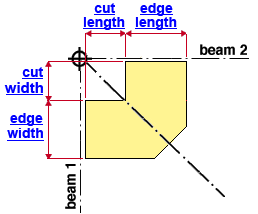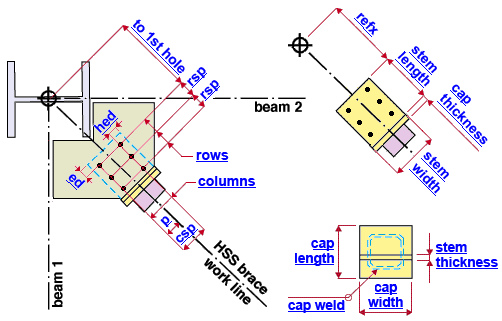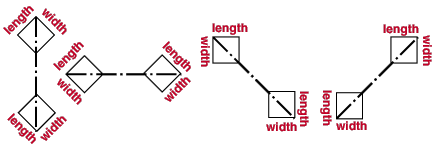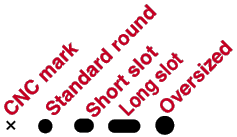"  Gusset To Two Beams " & "
Gusset To Two Beams " & "  Brace Connection To Gusset Hss Bolted "
Brace Connection To Gusset Hss Bolted "
| A " |
|
|||
| " (" Gusset cut " = ' Coped ')  |
" (" Gusset cut " = ' Coped ')  |
||
| " (welded tee end fitting for shop bolting the brace to the gusset plate)  |
|||
|
|
||
End connection failure message: Work point not at center of column .
Connection Guide: Click here for related screen shots.
User Defined Connections: Settings that are locked (
) in a user defined connection file will automatically be locked on a member edit window for which that file is the " Input connection type ." You can, if you so choose, manually lock additional settings on the member edit window, and your changes will be retained, through multiple processes, so long as you do not change to a different connection then switch back to the original user defined connection.
Horizontal Brace Edit: To change a setting, first set it to locked (
). Related settings that are unlocked (
) may be updated, and the "
Left/Right end limit state " calculations will be updated. Settings that are locked (
) will not be changed by connection design , even if doing so might prevent a connection failure.
Connection design locks :
| Locks not dimensioned or called out on the detail are marked ( not depicted ). |
![]() Gusset To Two Beams
Gusset To Two Beams
(HSS, pipe or tube horizontal brace to a beam-column-beam corner)
Plate thickness ( not depicted ): The " Material thickness " of the gusset plate.
Width ( plate width ): Below are some examples (in a plan view ) that can help you determine which edge the gusset plate is its width. Beam 1 field bolts to the width of the gusset plate using either a "
HB Conn 1 " flange connection or a "
NS/FS Clip Conn 1 " web connection. See the example above.
width is parallel with beam 1

Length ( plate length ): Below are some examples (in a plan view ) that can help you determine which edge of the gusset plate is its length. Beam 2 field bolts to the length of the gusset plate using either a "
HB Conn 2 " flange connection or a "
NS/FS Clip Conn 2 " web connection. See the example above.
length is parallel with beam 2

Refx: The distance parallel with the length edge of the gusset plate from the work point of the brace to the width edge of the gusset plate. Changing the " Refx " moves the plate only, not the holes on the plate.
Refy: The distance parallel with the width edge of the gusset plate from the work point of the brace to the length edge of the gusset plate. Changing the " Refy " moves the plate only, not the holes on the plate.
Beam connection clip cut width ( cut width ): This distance is measured parallel with the width of the gusset plate. The entry made here, together with the " Beam connection clip cut length ," set the dimensions of the cut at the work-point end of the gusset plate. The nature of this cut depends on whether the " Gusset cut " is a ' Cope ' or a ' Clip '. A ' Cope ' is shown in the example above. If the " Gusset cut " is a .' Clip '. then the distances entered here and to the " Beam Connection clip cut length " together set the angle of the cut. Entering the same distance for both settings results in a cut of 45 degrees. If the " Gusset cut " is a ' Cope ', then this is the distance from the framing edge of the gusset plate to the point where this cut meets the other cut that makes up the cope. This cut is parallel with the width of the gusset plate.
Beam connection clip cut length ( cut length ): This distance is measured parallel with the length of the gusset plate. The entry made here, together with the " Beam connection clip cut width ," set the dimensions of the cut at the work-point end of the gusset plate. The nature of this cut depends on whether the " Gusset cut " is a ' Cope ' or a ' Clip '. A ' Cope ' is shown in the example above. If the " Gusset cut " is a ' Clip '. then the distances entered here and to the " Cut width " together set the angle of the cut. Entering the same distance for both settings results in a cut of 45 degrees. If the " Gusset cut " is a ' Cope ', then this is the distance from the framing edge of the gusset plate to the point where this cut meets the other cut that makes up the cope. This cut is parallel with the length of the gusset plate.
Connection cut width ( ccut width ): The distance (parallel with the " Width " of the gusset plate) between the two corners of the connection edge of the gusset plate. The connection edge is the edge that the HSS horizontal brace frames to (see example ). This distance is not the actual width of the connection edge, but the width of that edge as measured parallel with beam 1.
Connection cut length ( ccut len ): The distance (parallel with the " Length " of the gusset plate) between the two corners of the connection edge of the gusset plate. The connection edge is the edge that the HSS horizontal brace frames to (see example ). This distance is not the actual length of the connection edge, but the length of that edge as measured parallel with the work line of beam 2.
Flat width: The distance between the two corners of the width edge that remains after the " Connection cut width " has been applied. The following formula applies: plate width - ccut width = flat width . In other words, " Width " - " Connection cut width " = " Flat width ."
Flat length ( flat_len ): The distance between the two corners of the length edge that remains after the " Connection cut length " has been applied. The following formula applies: plate length - ccut len = flat len . In other words, " Length " - " Connection cut length " = " Flat length ."
Connection edge width ( edge width ): The distance between the two corners of the width edge that remains after the " Beam connection clip cut width " has been applied. The following formula applies: plate width - cut width = edge width . In other words, " Width " - " Beam connection clip cut width " = " Connection edge width ." The connection edge of the gusset plate field bolts to the top flange of the beam if the gusset plate is to the top flange ("
HB Conn1 "). Otherwise, the connection edge bolts to the web of the beam with a clip angle ("
NS/FS Clip Conn1 ").
Connection edge length ( edge length ): The distance between the two corners of the length edge that remains after the " Beam connection clip cut length " has been applied. The following formula applies: plate length - cut length = edge length . In other words, " Length " - " Beam connection clip cut length " = " Connection edge length ." The connection edge of the gusset plate field bolts to the top flange of the beam if the gusset plate is to the top flange ("
HB Conn2 "). Otherwise, the connection edge bolts to the web of the beam with a clip angle ("
NS/FS Clip Conn2 ").
![]() Brace Connection To Gusset HSS Bolted
Brace Connection To Gusset HSS Bolted
(HSS, pipe or tube brace to a beam-column-beam corner)
Stem plate
Thickness ( stem thickness ): The " Material thickness " of the stem plate. For a perfectly horizontal horizontal brace, increasing the " Thickness " moves the bottom surface of the stem plate down, while the top surface remains at the same elevation. See the example .
Width ( stem width ): The distance between the two corners of the forward edge of the stem plate. Since the stem plate is rectangular, this is also the length of the edge of stem plate that welds to the cap plate. The width of the stem plate is perpendicular to the work line of the horizontal brace. See the example .
Length ( stem length ): The length of either of the two edges of the stem plate that are parallel with the work line of the horizontal brace. See the example .
The " Minus dimension " ( refx ) under "
Setbacks " on the Horizontal Brace Edit window can be used to adjust the refx distance that is shown in the example .
Refy ( not depicted ): The distance (perpendicular to the work line of the horizontal brace) from the work line of the horizontal brace to the length edge of the stem plate (the length edge is parallel with the work line). Changing the " Refy " slides the stem plate sideways (moves it perpendicular to the work line) -- it does not move the holes in the plate since hole placement is set on the gusset plate.
Refz ( not depicted ): The distance (perpendicular to the work line of the horizontal brace) from the horizontal brace work point to the top face of the stem plate. For a perfectly horizontal horizontal brace, this distance is vertical. A " Refz " of ' 0 ' places the top surface of the stem plate flush with the bottom surface of the gusset plate. Increasing the " Refz " moves the stem plate down, away from the gusset plate.
Stem plate to cap plate connection (shop welded)
Weld size ( stem weld ): The weld size for shop welding the back edge (top and bottom) of the stem plate to the cap plate. This is labeled "stem weld" in the example .
Stem plate to gusset connection (shop bolted)
Bolt diameter ( not depicted ): The diameter of the shop bolts that fasten the brace to the gusset plate. You can either type in any diameter (inches or mm), or you can select a bolt diameter from the combo box (
). The diameters that are listed in the combo box come from Home > Project Settings > Job > Bolt Settings > the " Available bolts " list. The bolt diameter entered here, together with the " Hole type " entered below, set the diameter of holes the bolts go into.
Hole type ( not depicted ): Standard round or Short slot or Oversized or Long slot or User slot #1 or User slot #2 . This sets the type of hole through which the brace will be bolted to the gusset plate in the shop.

Rows: The number of holes in any one column of holes. Entering ' 0 ' removes the holes. In the example above, the number of " Rows " is ' 3 '.
Distance to 1st hole along brace ( to 1st hole ): The distance parallel with the work line of the horizontal brace from the work point to the center of the nearest hole. See the example .
Hole spacing along brace ( rsp ): Row spacing. This is the distance (center to center) between any two adjacent holes in the same column of holes. Row spacing on a horizontal brace gusset plate runs parallel with the work line of the horizontal brace. See the example .
End connection failure message: Invalid bolt spacing
Edge distance along brace ( ed ): The distance from the forward edge of the welded-tee stem plate to the nearest hole in the stem plate. See the example . The forward edge is the stem plate edge that is closest to the work point of the HSS horizontal brace. Holes in the stem plate are for shop bolting the stem plate to the gusset plate.
Other edge distance along brace ( not depicted ): The distance from the edge of the gusset plate to the nearest hole for shop bolting the stem plate to the gusset plate.
Columns: The number of columns of holes for bolting the brace and gusset together in the shop. Bolt column spacing runs perpendicular to the work line of the brace. In the example above, the number of " Columns " is ' 2 '.
Distance to 1st hole perpendicular to brace ( p ): The distance from the work line of the horizontal brace perpendicular to the nearest column of holes in the stem plate. In the example above, this distance would be half the " Hole spacing perpendicular to brace " since the work line of the brace is centered between the two columns of holes.
Hole spacing perpendicular to brace ( csp ): Column spacing. The distance (center to center) between columns of holes (see example ). Column spacing runs perpendicular to the work line of the horizontal brace.
Horizontal edge distance ( hed ): The distance (perpendicular to the work line of the horizontal brace) from the length edge of the stem plate to the nearest column of holes for shop bolting the stem plate to the gusset plate. See the example .
Cap plate
Thickness ( cap thickness ): The " Material thickness " of the cap plate. Increasing the cap plate Adjusting the cap plate " Thickness " moves the back face of the cap plate toward the opposite end of the horizontal brace, while the forward face of the cap plate remains the same distance from the work point. See the example .
Width ( cap width ): On a horizontal brace that is perfectly horizontal, this is the width of either of the horizontal edges of the cap plate. See the example .
Length ( cap length ): On a horizontal brace that is perfectly horizontal, this is the length of either of the vertical edges of the cap plate. See the example .
Refx ( not depicted ): The distance (perpendicular with the work line of the horizontal brace) from the work line of the horizontal brace to the length edge of the cap plate. For a horizontal brace that is perfectly horizontal, this distance is horizontal. Changing the " Refx " slides the cap plate sideways.
Refy ( not depicted ): The distance (perpendicular with the work line of the horizontal brace) from the work line of the horizontal brace to the top edge of the cap plate. For a horizontal brace that is perfectly horizontal, this distance is vertical. Changing the " Refy " slides the cap plate up or down.
Cap plate to brace connection (shop welded)
Weld ( cap weld ): The weld size for shop welding the HSS, pipe or tube horizontal brace to the cap plate. This is labeled "cap weld" in the example .







